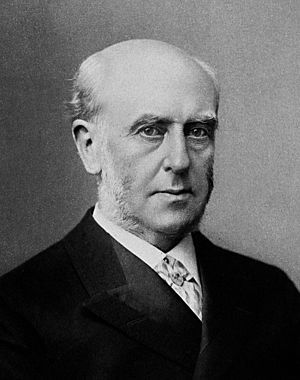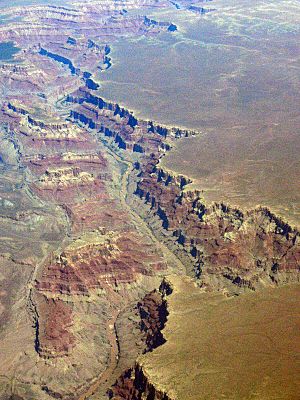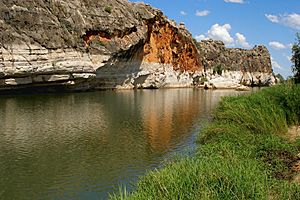Archibald Geikie facts for kids
Quick facts for kids
Archibald Geikie
|
|
|---|---|

Sir Archibald Geikie, by Wener & Son.
|
|
| Born | 28 December 1835 Edinburgh, Scotland
|
| Died | 10 November 1924 (aged 88) Haslemere, England
|
| Nationality | Scottish |
| Awards | Murchison Medal (1881) Wollaston Medal (1895) Royal Medal (1896) Hayden Memorial Geological Award (1902) |
| Scientific career | |
| Fields | Geology |
Sir Archibald Geikie (28 December 1835 – 10 November 1924) was a famous Scottish geologist and writer. He spent his life studying the Earth and how it changes. He was also a great writer, explaining complex ideas clearly.
Contents
Early Life and Education
Archibald Geikie was born in Edinburgh, Scotland, in 1835. His father, James Stuart Geikie, was a musician and music critic. Archibald was the older brother of James Geikie, who also became a well-known geologist. Archibald went to Edinburgh High School and then studied at the University of Edinburgh.
Starting His Career in Geology
In 1855, Archibald Geikie started working as an assistant for the British Geological Survey. This is a group that studies the rocks and land of Britain. He was very good at both fieldwork (using a hammer to study rocks) and writing. His first book, The Story of a Boulder, came out in 1858.
His skills quickly caught the eye of his boss, Sir Roderick Murchison. They became lifelong friends. Geikie later wrote a book about Murchison's life.
Mapping Scotland's Geology
Geikie and Murchison worked together on the complex rock formations in the Scottish Highlands. In 1862, they published a small geological map of Scotland. Geikie later released a larger map in 1892.
In 1863, Geikie wrote an important essay. It was about how ice had shaped Scotland's landscape. This was one of the first times someone clearly explained the effects of glaciers in that country.
Understanding Landforms
In 1865, Geikie published Scenery of Scotland. This book was special because it was the first to explain how the landforms of a country were created over time.
At this time, geologists in Edinburgh, like Sir Andrew Ramsay, believed that denudation was very important. Denudation is the process where water, ice, and wind wear away the Earth's surface. They thought that rivers carved out valleys. Geikie's book supported these ideas. He soon became a leader among these geologists.
Leading the Geological Survey
In 1867, a special branch of the Geological Survey was set up for Scotland. Geikie was chosen to be its director. He also became the first professor of geology at the University of Edinburgh in 1871. He held both jobs until 1881.
In 1881, he became the Director-General of the Geological Survey for the entire United Kingdom. He also directed the Geological Museum in London. He retired from these roles in 1901. During his time as director, he greatly improved the study of rocks under a microscope. He created a huge collection of very thin slices of British rocks for this purpose.
Studying Volcanoes and Erosion
From the start of his career, Geikie was very interested in volcanoes. He studied the geology of the Isle of Skye and other Western Isles in Scotland.
He also traveled widely, including to Europe and western America. When he saw the deep canyons of the Colorado River, it confirmed his ideas about how rivers carve out land. In places like Wyoming, Montana, and Utah, he gathered important information about volcanoes. He wrote about his findings in his book The Ancient Volcanoes of Great Britain (1897).
His Many Books
Geikie wrote many books. He wrote biographies of other famous geologists like Edward Forbes, Sir Roderick Murchison, and Sir Andrew Ramsay.
His book Founders of Geology came from lectures he gave in 1897. In 1897, he also published a Geological Map of England and Wales. He wrote about how different types of scenery influenced literature in his 1898 book, Types of Scenery. He also helped improve the teaching of physical geography in Britain with his book The Teaching of Geography (1887). Other books include Scottish Reminiscences (1904) and Landscape in History (1905). He even wrote a book about the Birds of Shakespeare in 1916.
Awards and Recognition
Archibald Geikie received many honors for his work. He was the President of the Geological Society of London multiple times. He also served as President of the British Science Association in 1892.
He was a member of the Royal Society, a very important scientific group. He was their Foreign Secretary and later their Joint Secretary. In 1909, he was elected President of the Royal Society. He received their Royal Medal in 1896.
He was given a knighthood in 1891, making him "Sir Archibald Geikie." He also received the Order of the Bath in 1907 and the Order of Merit in 1914.
Many things are named after him, including:
- Dorsa Geikie, a system of ridges on the Moon.
- The mineral geikielite.
- Geikie Gorge in Western Australia.
- Mount Geikie in the Canadian Rockies.
- Geikie Peak in the Grand Canyon.
- The Geikie Slide in the Atlantic Ocean near Scotland.
Later Life and Family
Sir Archibald Geikie passed away on November 10, 1924, at his home in Haslemere, England. He is buried in the village churchyard there.
He married Alice Gabrielle Anne Marie Pignatel in 1871. They had one son, Roderick, who died young, and three daughters: Lucie, Elsie, and Gabrielle.
Images for kids
-
Charles Doolittle Walcott, John Wesley Powell, and Sir Archibald Geikie on a geological field trip in Harpers Ferry, West Virginia, May 1897.
See also
 In Spanish: Archibald Geikie para niños
In Spanish: Archibald Geikie para niños







